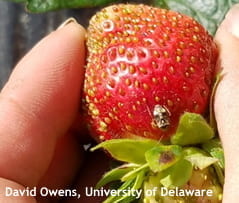David Owens, Extension Entomologist, owensd@udel.edu
This spring, cold weather has interfered with strawberry pollination resulting in misshapen berries. But there is another cause of deformed fruit: tarnished plant bug. Tarnished plant bugs are a brown to black, mottled, and small true bug with a creased back. Like all true bugs, they have piercing-sucking mouthparts. Nymphs are green and can easily hide, but when disturbed move very quickly, unlike aphids, which they resemble. Adults feed, reproduce, and overwinter on an enormous variety of weedy and cultivated hosts, especially brassicas and legumes. Although the weather has since cooled, our warm winter and early spring allowed for earlier TPB activity; typically these are more problematic on late varieties and everbearing varieties. When adults and nymphs feed on the flowers and developing fruit, they kill a portion of the tissue while the rest of the berry continues to develop around the dead spot. The insect does not feed on the seeds, thus, they will all be of the same size unlike distorted berries due to poor pollination. They often feed and damage entire berry clusters.
There are a couple of ways to sample for TPB. The first method involves beating an entire plant over a sheet and repeating every 20 feet or so. The threshold used in the South is 1 adult or nymph per 20 plants. The other sampling method, more useful for nymphs than adults, involves beating 30 flower clusters throughout the field. UMass has a good table explaining sequential sampling where, depending on the number of insects and flower clusters examined, control is either not necessary – stop sampling, necessary – stop sampling, or if in between – keep sampling. This can result in a significant time savings. (https://ag.umass.edu/fruit/fact-sheets/strawberry-ipm-tarnished-plant-bug).
You can sample for the presence of tarnished plant bug by using a beat sheet or by beating plants on plastic. (White is often recommended and adults will be easy to spot, but small green nymphs tend to be easier to see on a black background). Sample one plant every 20 feet or so. If you find one adult or nymph per 20 plants, a treatment is advised. Keep in mind though that once a berry is deformed, the damage is done. Berries like the ones below were fed upon a couple of weeks prior.
There is a plethora of available synthetic insecticide treatments available. Several pyrethroids are labeled, with varying pre harvest intervals. Malathion is also labeled, as is Assail. Newer chemistries include Apta (also has some powdery mildew activity), Transform, and Beleaf. Among these, only Beleaf is rated as having low bee toxicity. Be careful not to spray when bees are active; you do not want to risk having deformed fruit by poor pollination when trying to prevent deformed fruit by TPB. PyGanic and azadirachtin are organic options.
Berry deformed by TPB feeding
A damaged berry cluster due to TBP
A late instar TPB nymph
An adult tarnished plant bug
An early instar on the upper sepal demonstrating how well nymphs blend in.





